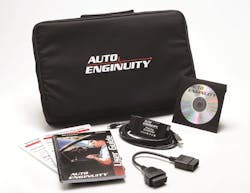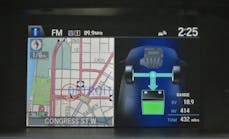Tools used:
- Multimeter
- Lab scope
- Scan tool
- Vehicle information
Most technicians use their scan tools in a way that matches how they perform diagnostic tests on vehicles. In many cases this method starts with obtaining fault codes, then analyzing the datastream to determine which system or components are not operating correctly. The technician may or may not use freeze frame data to help confirm what the vehicle is doing when the issue occurred, then after the repair is complete they will clear the codes.
This works effectively most of the time, but if this is the only way in which you use your scan tool, you are not getting the most out of it. Once you understand what your scan tool can do, and how to use it better, you can become more efficient, and possibly have fewer instances of misdiagnosis, or incomplete diagnosis issues.
If you are not familiar with your scan tool, the previously described method of testing only used four of the nine available modes on most scan tools.
Scan tools provide the following modes of operation:
Mode 1 – Observe current datastream
Mode 2 – Obtain freeze frame data
Mode 3 – Obtain diagnostic trouble codes (DTCs)
Mode 4 – Clear codes and data
Mode 5 – Obtain oxygen sensor data monitor
Mode $06 – On-board monitoring results
Mode 7 – Obtain emission related DTCs during current or last completed drive cycle
Mode 8 – Bidirectional control of specific systems
Mode 9 – Request vehicle identification information
In this Tool Briefing, we will be discussing how to get more from your scan tool by using Mode $06. Many technicians either do not understand what Mode $06 is, or they do not appreciate the value of using it. In my travels as an instructor teaching Mode $06, I ask the students how and if they currently use this function of their scan tools. The overwhelming majority of them say they do not use it other than to monitor misfire data, specifically on Ford products. Granted, this can be valuable information, but Mode $06 has the ability to go far beyond providing misfire test results.
The best uses of this mode are to determine if a monitored system is functioning within its parameters, or to see if the system is close to failing, and in many cases why the monitor is not, or has not, completed.
Mode $06 provides the technician with the results of monitored tests the PCM performs to determine if a system or component is functioning within the parameters that will keep the vehicle in emission compliance. Basically, if a “check engine” light is on, the vehicle has failed at least one test in a series of electrical and functional tests the PCM uses to determine if the monitored system is operating in a way to keep the vehicle in emission compliance. The “check engine” light will illuminate if the system is malfunctioning, and the failure will cause the emissions to rise to 1.5 times or more of the federal test procedure limit. The results of that monitored system test, along with results from all the other monitored systems, whether they passed or failed, can be viewed in Mode $06 of your scan tool.
Making sense of Mode $06 – Using your scan tool
In order to understand Mode $06, you need to realize it is a function of generic, or global, OBD-II. As such, depending on the scan tool, you may need to exit from the OE vehicle-specific enhanced function and enter into a global OBD-II function. It should be noted that many of the newer scan tools will automatically move from one area to the other without needing to exit, which can save quite a bit of time.
Another thing you will need to understand is that there are specific systems that are monitored. These are indicated on the scan tool as a CID, or Component Identification. Each CID is composed of a series of tests to determine whether all of the components necessary to operate and monitor the functions of that system are operating properly. These individual tests are listed as TIDs, or Test Identifications.
For example, a CID shown as $80 and a TID shown as $21 on a 2011 Ford, will indicate the test is for a catalytic converter monitor, and the component test is analyzing the switch ratio of the rear oxygen sensor on bank 1 (see Fig. 1). (Information on how to identify specific CIDs and TIDs is discussed later in this article.) Additionally, Mode $06 provides the results, the test parameter limits, and the unit of measure on your scan tool. It also indicates whether the test has been completed and, if so, if it passed or failed. In our catalytic converter example, the numbers provided on the scan tool will show the minimum switch ratio allowed, the actual ratio the sensor is switching compared to the front oxygen sensor, if the test has been completed, and whether the last test performed passed or failed the test (see Fig. 2).
Making sense of Mode $06 – Obtaining information
Once you are able to view Mode $06 data, you will see that it is listed in a hexadecimal (hex) format. In automotive uses the “$” sign indicates that the numbers following it are hexadecimal. The dollar sign is used because it relates value, meaning the numbers following the “$” sign are a specific value, not a common number.
Mode $06 utilizes a hexadecimal (hex) format to identify the system (CID), the specific test(s) (TID) performed, and the results and limits of those tests. Most current scan tools have the ability to display Mode $06 in both hex and a translated, or converted, format. With a converted format, you have the ability to see very specifically what and how components and systems are being tested. If test results are close to a failing limit, you have the choice of either advising your client to do further repairs or testing. You also have the ability to advise or warn your client of possible additional issues in the future. If you are using a scan tool that does not translate hex into a format that you can use, you will need to spend some time to obtain specific vehicle data and convert the hex data into recognizable terms.
Your traditional subscription services like Mitchell 1, ALLDATA and Identifix all have some information available, but depending on the vehicle the information may not be that helpful (see Fig. 3). Other resources for Mode $06 information are available at nastf.org and OEM1stop.com. Both of these sites are used to access information direct from the automotive manufacturers, much of it at no charge. The benefit to these two sites is they have links to the OE manufacturers on their sites and, since the information is all in one spot, this make it easier to locate information.
Using Mode $06 – What to do with it
Once you are in Mode $06 with your scan tool, and are observing a specific monitor and test, what does it mean to you? This is where the real value of using this part of your scan tool comes in, and also where you may need to change your diagnostic process and mindset.
Let’s say you are diagnosing a vehicle with an illuminated “check engine” light. Your traditional test process without the addition of Mode $06 has found a P0300 DTC, indicating random, or multiple, misfires (see Fig. 4). Freeze frame data shows the misfires are occurring at idle, and it also indicates the system is running too rich.
Armed with this information, you look at the datastream and perform additional tests that determine there is a faulty fuel pressure regulator which is leaking fuel into the intake manifold during idle. After replacing the fuel pressure regulator and the spark plugs, which were fuel fouled, the vehicle road tests fine and the “check engine” light is off.
Using your prior test and repair methods, the vehicle is repaired and has no problems. If you want to make sure the vehicle is repaired completely, you should check to make sure the monitor tests are complete and have passed. Observing Mode $06 you will be able to confirm every test has passed and the systems are operating within the parameters that will not cause any issues.
Full use of Mode $06 can take verifying the vehicle is completely repaired a step further, though. All of us have had instances where you repair a vehicle and it returns after being driven for a few days with the “check engine” light on again. If this occurs, your customer of course will assume it is illuminated for the same reason it was originally, and assume you did not fix their vehicle properly.
For instance, if the vehicle that was over-fueling had been tested using Mode $06, you likely would have seen information that could have prevented a come-back. We all understand that unburned fuel in the exhaust will cause damage to the catalytic converter. If you used Mode $06 to look at the catalyst monitor test and saw that the test had passed, but the value was near the fail limit (see Fig. 5), you could have advised your customer of the probability the catalytic converter had been damaged from the leaking fuel pressure regulator. Even if the customer declined the additional work, you let them know there was a potential issue and if the “check engine” light does come on again, it would not result in the customer thinking you did not fix their vehicle properly.
Other things to consider with Mode $06 are that while the on-board computer system is able to determine if specific monitored systems are functioning electrically and within set parameters or not, it assumes the sensors it is utilizing for each test are reporting correctly.
Let’s use an ambient or intake air temperature sensor (IAT) as an example. If the sensor is faulty and misreporting the air temperature, monitors that rely on correct air temperature may not be able to detect an issue. The EVAP monitor uses the ambient IAT sensor to help determine if there is a leak in the system. As the temperature rises, pressure within the tank should also rise. If the pressure does not rise enough, the monitor assumes there is a leak in the system. If the sensor is not reporting a change in temperature to the PCM, it will not expect to see either a rise or drop in tank pressure and therefore will not be able to detect a leak in the evap system.
In order to make sure all of the sensors are able to function correctly, use your scan tool to observe the PIDs and compare them to what you should be seeing for the conditions. If you suspect a sensor issue, use your lab scope or DMM at the sensor to see if the power and ground signals match conditions as they change.
To sum it up, you will not become an expert with Mode $06 overnight, and most likely will not see the full value of using it until you invest some time with it. But its use can save you from having comeback issues that could have been prevented.



